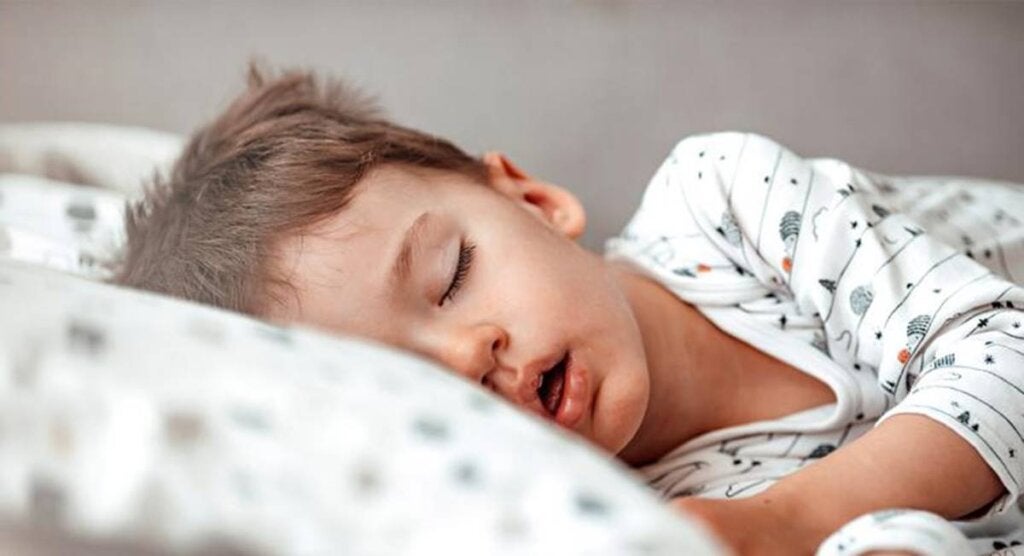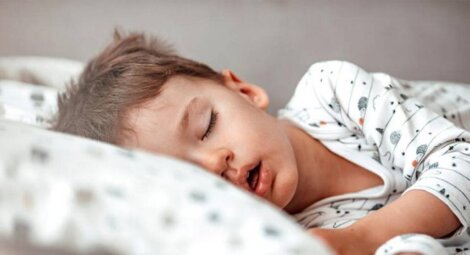There may be a health problem behind the child snoring and wetting the bed. Sleep apnea does not only appear in adults, but children also suffer from it and its effects are serious.
Sleep apnea in children is a respiratory condition that requires our attention. So much so that, according to pediatric associations, it has an incidence of 10% among the infant population. This percentage can sometimes increase, since in many cases there may be enlarged tonsils or adenoids behind this reality.
Therefore, although apnea is such a recurring sleep disorder among adults, it still continues to be underestimated today. Many assume that snoring is normal and therefore irrelevant. However, what snorers experience are brief respiratory arrests, with all that this entails (lack of oxygen to the brain, heart disease, hypertension…).
In children, this condition can be more serious than in adults. Therefore, it is essential that parents and caregivers take care of the quality of sleep of the little ones from the very beginning. It is calculated that it makes its first appearance before the age of 5; in addition, it presents with other more complex symptoms than those typical of elderly people. We analyze it.
Among the effects of not diagnosing sleep apnea early in children are cardiopulmonary problems, daytime sleepiness, inflammatory diseases, etc.
Sleep apnea in children, what are the symptoms?
Sleep apnea in children is the onset of continuous episodes of respiratory failure during night rest. Meaning what, there is an obstruction in the upper respiratory tract that lasts between 8 and 10 seconds.
A study by the University Hospital of Oulu (Finland) highlights an important thing in this regard: any child who snores can suffer from obstructive sleep apnoea.
Furthermore, sometimes there may be children under the age of two who snore loudly during rest. However, it is not so easy to diagnose, various tests are required to be able to differentiate them from primary snoring (common and non-pathological).
Let’s see the main associated symptoms.
Features associated with sleep apnea in children
In the first place, snoring or noisy breathing is the most common symptom associated with sleep apnea in children. Likewise, we must take into account that it can already appear in babies of a few months.
Research papers, such as those produced by Harvard Medical School in Boston and the University of Texas Southwestern Medical Center in the United States, point to something relevant.
Some children have both an anatomical and physiological predisposition to airway obstruction. This can hamper their growth due to lack of oxygen. In some cases, it could be behind sudden deaths. Therefore, if a child snores, it is crucial to consult the pediatrician.
On the other hand, in addition to this characteristic, others are usually added in children between 2 and 10 years of age:
- Nocturnal urination.
- Daytime exhaustion.
- Lack of concentration.
- Irritability and bad mood.
- Heachache.
- sweating.
What are the causes of sleep apnea in children?
The origin of sleep apnea in children is in several variables. The most common is in vegetations or enlarged tonsils. This can be resolved with surgery which, as we all know, is very common in the child population and, surely, many of us have undergone it.
Other factors associated with this respiratory and sleep disorder are the following variables:
- Congenital anomalies of the respiratory tract. Examples of this are laryngomalacia, piriformis orifice stenosis, hemangiomas, etc.
- Childhood overweight is another recurring reality.
- Last but not least, it should be noted that both Down syndrome and Pierre Robin syndrome are associated with sleep apnea in children.
How is it diagnosed?
When it comes to knowing if a child has obstructive sleep apnea, it’s not enough to know that he snores. There are multiple variables that need to be analyzed clinically to make an accurate diagnosis:
- The most common test performed is a sleep polysomnography. It consists of recording the child’s brain waves, heart rate, respiratory rate, blood oxygen levels, eye and leg movements over one or more nights.
- Urinary biomarkers and rhinomanometry should also be obtained.
Treatment suitable for children
The treatment of this condition requires starting from the clinical reality of the child. In other words, there will be little ones who need simple tonsil surgery and others who may need to lose weight to improve their breathing. Anyway, the most important thing is to go to the pediatrician and the pediatric otolaryngologist to find out the best treatment.
However, it should be noted that, as with adults, the most used technique is the treatment with positive airway pressure (PAP). It consists of sleeping connected to a machine that keeps the trachea open, thanks to the constant pumping of pressurized air into the airways of the lungs.
To conclude, let us recall once again that snoring is not always normal in humans. Knowing the source and following medical guidelines can improve your quality of life. In children, this problem is even more important.
It may interest you …
All sources cited have been thoroughly reviewed by our team to ensure their quality, reliability, currency, and validity. The bibliography for this article has been deemed reliable and of scholarly or scientific accuracy.
-
Anderson, I. C., Sedaghat, A. R., McGinley, B. M., Redett, R. J., Boss, E. F., & Ishman, S. L. (2011). Prevalence and severity of obstructive sleep apnea and snoring in infants with Pierre Robin sequence. The Cleft palate-craniofacial journal : official publication of the American Cleft Palate-Craniofacial Association, 48(5), 614–618. https://pubmed.ncbi.nlm.nih.gov/20815709/
-
Brockmann, P. E., Schaefer, C., Poets, A., Poets, C. F., & Urschitz, M. S. (2013). Diagnosis of obstructive sleep apnea in children: a systematic review. Sleep medicine reviews, 17(5), 331–340. https://pubmed.ncbi.nlm.nih.gov/23375659/
- National Heart, Lung, and Blood Institute. (December 23, 2021). Childhood sleep apnea linked to high blood pressure in adolescence. NIH Medline Plus Journal. https://magazine.medlineplus.gov/es/art%C3%ADculo/apnea-del-sueno-en-la-infancia-se-relaciona-con-presion-arterial-alta-en-la-adolescence
- Gómez-Pastrana, D., & Álvarez-Gil, D. (2017). Sleep apnea-hypopnea syndrome. Diagnostic and Therapeutic Protocols in Pediatric Pneumology1, 237-251. https://www.aeped.es/sites/default/files/documentos/15_sindrome_apneas_hipopneas_0.pdf
- Katz, E. S., Mitchell, R. B., & D’Ambrosio, C. M. (2012). Obstructive sleep apnea in infants. American journal of respiratory and critical care medicine, 185(8), 805–816. https://www.ncbi.nlm.nih.gov/pmc/articles/PMC5448577/
-
Leon-Astudillo, C., Lee, G. S., & Katwa, U. (2019). An Unusual Case of Noisy Breathing in an Infant. Journal of clinical sleep medicine, 15(1), 149–152. https://pubmed.ncbi.nlm.nih.gov/30621832/
-
Li, Z., Celestin, J., & Lockey, R. F. (2016). Pediatric Sleep Apnea Syndrome: An Update. The journal of allergy and clinical immunology. In practice, 4(5), 852–861. https://pubmed.ncbi.nlm.nih.gov/27372597/
-
Narang, I., & Mathew, J. L. (2012). Childhood obesity and obstructive sleep apnea. Journal of nutrition and metabolism, 2012134202. https://www.ncbi.nlm.nih.gov/pmc/articles/PMC3432382/
-
Nieminen, P., Tolonen, U., & Löppönen, H. (2000). Snoring and obstructive sleep apnea in children: a 6-month follow-up study. Archives of otolaryngology-head & neck surgery, 126(4), 481–486. https://jamanetwork.com/journals/jamaotolaryngology/fullarticle/404567
-
Tan, Y. H., How, C. H., Chan, Y. H., & Teoh, O. H. (2020). Approach to the snoring child. Singapore medical journal, 61(4), 170–175. https://www.ncbi.nlm.nih.gov/pmc/articles/PMC7905134/

